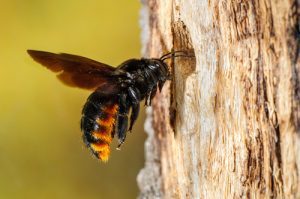Carpenter Bees – What’s the Buzz?
By Chris Williams on April 12, 2011.
Pesky carpenter bees nest in unfinished wood members causing damage to both structure and appearance. Though each nest may only extend 6 to 12 inches, multiple bees may work in the same area and expand on old nest tunneling systems. Over time these hollow spaces may encourage water damage, reduce structural integrity, and in some cases attract wood peckers. Once enough damage has been sustained, costly repairs must be made. Restoring the original look and function of the damaged members may be difficult due to height issues or other safety concerns.

Carpenter bees are found throughout North America and several species exist depending on where you are located. The two groups of carpenter bees are separated by size and nesting site preference. Ceratina, or “little carpenter bees”, only a tiny 6mm in length, usually metallic in color. Preferred nesting sites of the little carpenter bee include hollow stems and reeds, hollowed out stems of pithy plants. Little carpenter bees are of little concern to the homeowner as they never nest in structural members.
Xylocopa bees are robust, and resemble bumble bees, with less hair on the abdomen. These species are the ones associated with damage to structures. The Hawaiian carpenter bee females are bright orange with metallic green eyes. The carpenter bee we find in New England is known as Xylocopa virginica virginica, which ranges from Maine to Florida and westward to Nebraska and Texas. Both males and females are large and black, marked with areas of yellow hair. Compared to bumble bees, carpenter bees are almost bald, exhibiting a metallic shine, males have a yellow spot located on the head between the large, clearly visible eyes. Both males and females over winter in abandoned nest galleries.
Harsh winter conditions may kill many of the over wintering carpenter bees. In the springtime, adults emerge from their winter slumber in search of nectar. Sugars are needed to power the strong fliers as mating takes place and nest building begins. Nesting may take place in existing nest galleries, extensions of existing galleries, new chambers in a new location, or near an entrance hole used by other bees.
Suitable locations quickly become riddled with entrance holes, from multiple bees working independently. There is no “colony” or “nest” of carpenter bees. Unlike honey bees and some wasp species, who make structures of wax or paper in a communal way, carpenter bees work alone in the same conducive area. Old rotten tree limbs in nature provide natural locations for nesting, while trim boards, siding, fences, poles, posts, beams, soffits, doors, picnic tables, swing sets and other wooden articles typically found around human habitations provide ideal nesting conditions. 1×6 rake boards, facing south, loosing paint on the outside, and unpainted on the backside are a great example of a perfect carpenter bee residence. Warmth on sunny days and protection from the rain during inclement weather. Entrance hole facing the house on the back, un-painted side of the rake board. Typical yellow to brown fecal staining present on siding below the entrance hole mark activity and may build up over time. New galleries may only be 3 to 4 inches in length, but many bees working together may construct chambers 3 to 6 feet long.
Males collect pollen and nectar while females, the only sex with a stinger, do most of the excavation. A mixture of regurgitated pollen and nectar is packed into the bottom end of the brood gallery where an egg is laid. The female then seals off the chamber with a disk of wood pulp. She repeats this process several times. As the bees grow they eat the food mixture deposited, after pupation within the chamber, newly formed adults may also eat this material for energy. Development takes place in roughly 35 days. Adult bees die before the next generation arrives. The newly hatched bees behave differently than their parents, gathering and storing pollen in old tunnels. These food stores are used during bad weather and to build up fat supplies for hibernation. No mating or nest building takes place during this time, typically after July. These over wintering bees form the next seasons mating population.
In Spring, the strong and aggressive males will attack and try to either defend their territory or mate with any insects flying around. Inquisitive males may visit the patio table and fly quite close to humans or defend nest sites from painters, but they cannot sting. Waving a hand around is usually sufficient to scare them off if necessary. Females do have a stinger but they tend to be in the nest, and only sting when handled.
Carpenter bees can be safely controlled with direct pesticide applications, but that may not solve the problem. Replacing favorable wood applications with composite or plastic trim will resolve the issue permanently. Where possible exposed wood should be coated with some permanent finish. Prevention of access to untreated surfaces is also important. Gaps in vents, gable, louvers etc. may let carpenter bees into areas that are ideal for nesting, sawdust falling out all over the patio! The first step towards resolving carpenter bee issues is a professional opinion. Pest Control Professionals will be able to make specific recommendations for your unique situation.